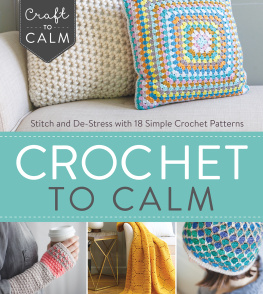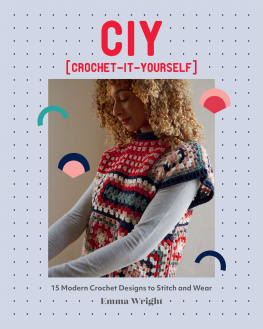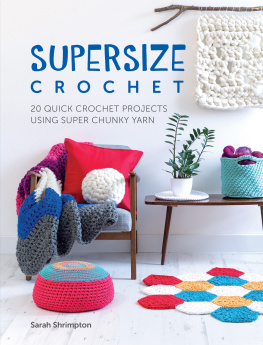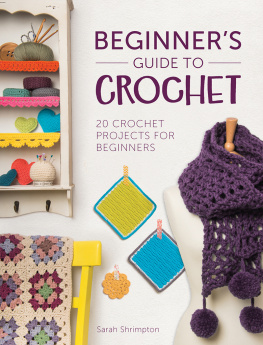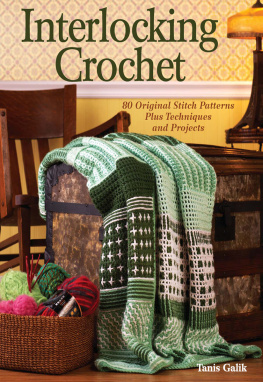Contents
Guide

By the Editors at Interweave
Foreword by Mandy OSullivan of @craftastherapy

dedication
To our wonderful readers! May you feel much calm and relaxation making these simple, elegant designs, and enjoy the results for years to come.
contents
foreword
Welcome to Crochet to Calm.
I'm very excited about being a part of this fabulous book as I really believe in the therapeutic benefits of crochet. I've always loved creating things with my hands, but it was during a particularly stressful period of my life that I began to immerse myself in crafting as a way to calm and de-stress. An avid crafter since I was a child, it was a natural choice for me to distract myself from life's stresses by focusing on creative projects; playing with color, texture, and pattern has always made me feel happy. And since a close friend taught me how to crochet a few years ago, it's become my favorite way to unwind. Everyone is looking for some downtime, and crochet is the perfect activity to promote calmness.
I get an enormous sense of pride and accomplishment when I've created something from scratch, but crafting is more than that for me. It's an underutilized form of therapy that can produce real stress reduction and management. We all live busy lives with our stress levels often at a heightened state, and I believe that crocheting can have a significantly positive effect on these levels. The repetitive movement in the creation of stitches, the beautiful textures and happy colors of yarn available, combined with the concentration required to follow a pattern, will often distract our tired minds from the stress of general life and force us to focus on the project at hand. And while concentrating on a crochet project won't solve life's problems, sometimes it can provide a much-needed break from stress and worry so that the mind can relax and refreshhelping to prepare it for the next day's challenges.
To reap the therapeutic rewards of crafting, I believe a project needs to meet a couple specific requirements: (1) It needs to contain repetitive movements that feel meditative, and (2) it needs to be challenging enough so it distracts and occupies ones mind, but not too difficult as to be frustrating. The very nature of crochet means that it will always meet the first requirement; creating crochet stitches requires a repetition of movement that creates a physical sense of calm. The second requirement depends on the individual; a project that fits the brief for one crocheter may not be suitable for another. For me, a mandala will always be my go-to project for when I'm feeling anxious or uptight, but you should choose a project that will work for you and enjoy the process of creating, not just the end result.
I feel honored to be introducing these gorgeous projects, created by a showcase of talented designers. I don't know about you, but I can't wait to pour a cup of tea, put my feet up, and hook in.
enjoy!
Mandy OSullivan

of @craftastherapy on Instagram
FOR THE
home

market TOTE
BY KATE DOHN
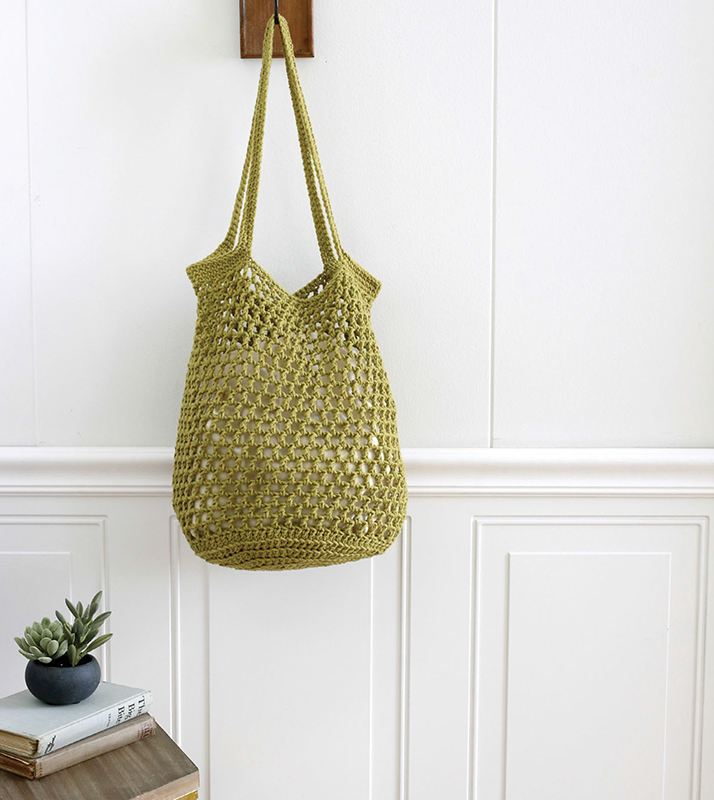
This crochet tote is the perfect bag for any trip to pick up some groceries. Made with 100% cotton yarn, it has a natural look that also provides durability. Ideal for everyday use, it has a closed circular bottom, open work/filet crochet body, and a double-strap top for easy carrying.
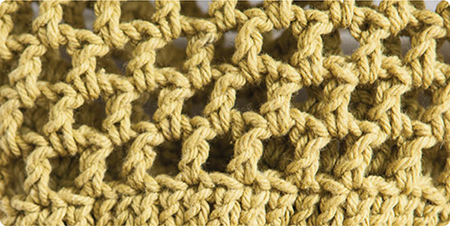
FINISHED SIZE
About 15" (38 cm) wide x 17" (43 cm) tall. Each strap measures 24" (61 cm) long.
YARN
Worsted weight (#4 Medium).
SHOWN HERE: Lion Brand Cotton (100% cotton; 236 yd/216 m; 5 oz/140 g); #760-134 Avocado, 2 balls.
NOTIONS
Yarn needle.
HOOK
Size J-10 (6.0 mm).
GAUGE
First 3 rnds = 4" (10 cm) in diameter. 12 sts and 6 rows = 4" (10 cm) on size J hook. Adjust hook size if necessary to obtain correct gauge.
NOTE
- To adjust the size of your finished tote, choose a larger hook and bulkier yarn or smaller hook and thinner yarn. The finished number of sts is denoted at the end of each row.
TOTE
RND 1: Ch 3 (count as dc), 11 dc in 3rd ch from hook, join with a sl st in top of beginning ch-2. (12 dc)
Work in back loops only for Rnds 27.
RND 2: Ch 2 (count as dc here and throughout), dc in same sp, 2 dc in each dc around, join with a sl st in top of beginning ch-2. (24 dc)
RND 3: Ch 2, dc in same sp, dc in next dc, *2 dc in next dc, dc in next dc; rep from * around, join with a sl st in top of beginning ch-2. (36 dc)
RND 4: Ch 2, dc in same sp, dc in each of next 2 dc, *2 dc in next dc, dc in each of next 2 dc; rep from * around, join with a sl st in top of beginning ch-2. (48 dc)
RND 5: Ch 2, dc in same sp, dc in each of next 3 dc, *2 dc in next dc, dc in each of next 3 dc; rep from * around, join with a sl st in top of beginning ch-2. (60 dc)
RND 6: Ch 2, dc in same sp, dc in each of next 4 dc, *2 dc in next dc, dc in each of next 4 dc; rep from * around, join with a sl st in top of beginning ch-2. (72 dc)
RND 7: Ch 2, dc in same sp, dc in each of next 5 dc, *2 dc in next dc, dc in each of next 5 dc; rep from * around, join with a sl st in top of beginning ch-2. (84 dc)
RND 8: Ch 2, working in both the back loop of each dc and the back horizontal loop of the same dc, dc in each dc around, join with a sl st in top of beginning ch-2. (84 dc)
RND 9: Working in both loops of sts, ch 4 (count as dc, ch 2 here and throughout), skip next dc, *dc in next dc, ch 2, skip next dc; rep from * around, join with a sl st in second ch of beginning ch-4. (42 dc; 42 ch-2 sps)
RND 10: Ch 3 (count as dc, ch 1 here and throughout), *dc in next ch-2 sp, ch 2; rep from * around, dc in last ch 2 sp, ch 1, join with a sl st in second ch of beginning ch-3. (43 dc; 2 ch-1 sps; 41 ch-2 sp)
RND 11: Ch 4, skip next ch-1 sp, *dc in next ch-2 sp, ch 2; rep from * around, skip last ch-1 sp, join with a sl st in second ch of beginning ch-4. (42 dc; 42 ch-2 sps)
RNDS 1216: Rep Rnds 1011 twice; then rep Rnd 10 once.
RND 17: Ch 4, skip next ch-1 sp, *dc in next ch-2 sp, ch 1, [dc in next ch-sp, ch 2] 8 times; rep from * around to last 3 sps, [dc in next ch sp, ch 2] twice, skip next ch-1 sp, join with a sl st in second ch of beginning ch-4. (42 dc; 4 ch-1 sps; 38 ch-2 sps)
RND 18: Ch 3, *dc in next ch-2 sp, ch 1, [dc in next ch-sp, ch 2] 7 times; rep from * around to last 5 sps, dc in next ch-sp, ch 1, [dc in next ch sp, ch 2] 4 times, dc in next ch-sp, ch 1, join with a sl st in second ch of beginning ch-3. (43 dc; 7 ch-1 sps; 36 ch-2 sps)

